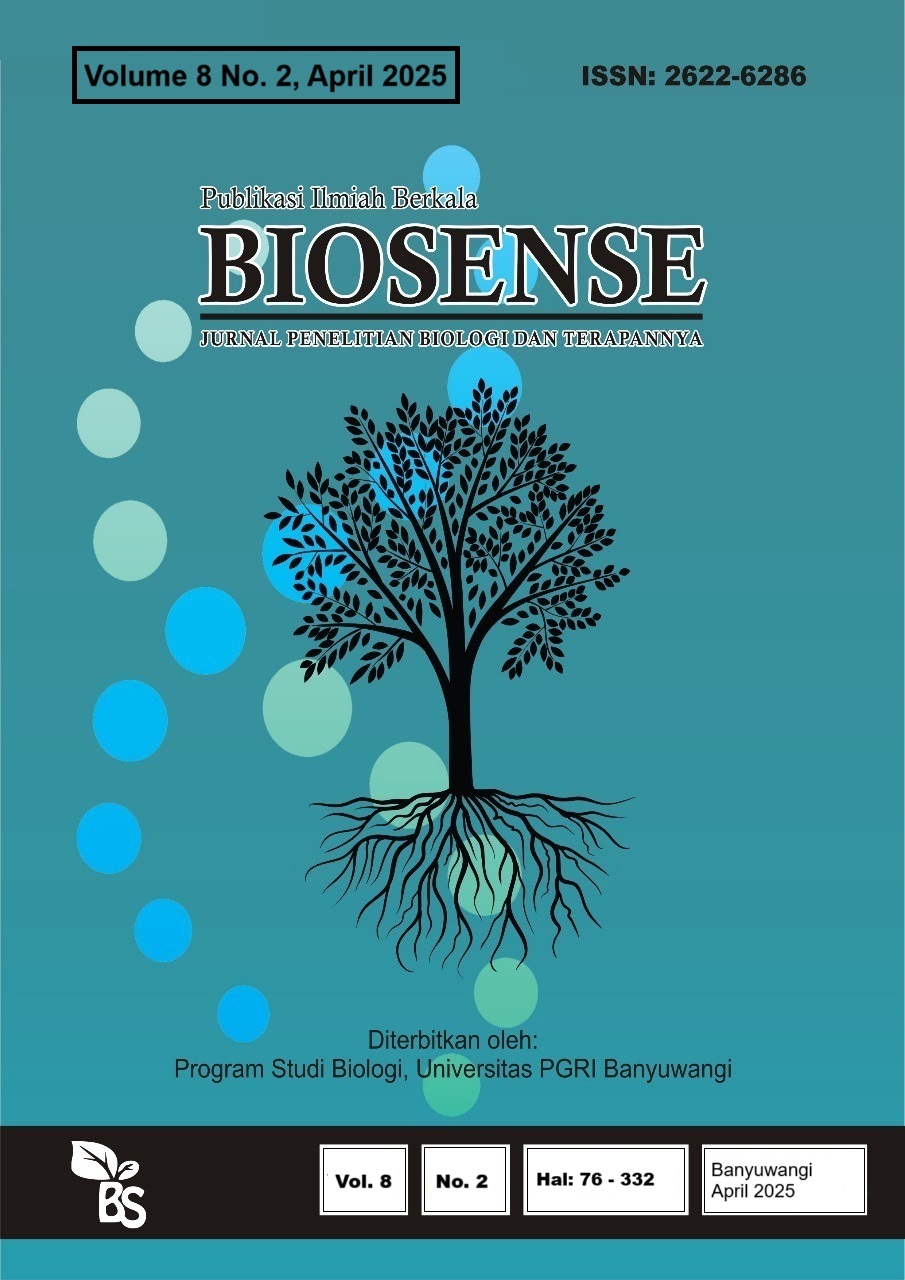EKSPLORASI TUMBUHAN PAKU PADA BEBERAPA HABITAT DI KABUPATEN MANOKWARI, PROVINSI PAPUA BARAT
DOI:
https://doi.org/10.36526/biosense.v8i2.5179Keywords:
habitat exploration, Psilotum, Lycopodium, fern bioprospectingAbstract
Exploration studies of ferns in Papua Indonesia are still limited, while habitat pressure is increasing due to massive development. The purpose of this study was to quickly explore potential habitats of ferns in several areas in Manokwari Regency, West Papua Province. Direct observation methods and fern collections were carried out without observation plots. The ferns collected were unique and rare ferns. Samples from the collection were then carefully observed and made into sketches to facilitate the description process. Taking research location points and measuring environmental parameters were also carried out in areas where ferns were found. The results of the study showed that there was a diversity of habitat types, environmental conditions and how ferns grew. 10 types of ferns were found from four observation locations. The ten ferns were Psilotum nudum, Psilotum complanatum, Microsorum diversifolium, Nephrolepis biserrata, Blechnum orientale, Lycopodium cernuum, Lycopodium phlegmaria, Selaginella wildenowii, Stenochlaena palustris, and Lygodium microphyllum. Rare species tend to be less abundant, while cosmopolitan and potentially invasive species are very abundant. Literature studies show that more than 80% of the fern species that have been successfully inventoried have the potential to be medicinal plants. Based on the results of this initial study, quantitative ecological studies and bioprospection of ferns in Manokwari, West Papua still need to be carried out as an effort to conserve ferns
Keywords: habitat exploration; Psilotum; Lycopodium; fern bioprospecting
References
Arya, V., Parmar, R. K., Gill, A. K., & Jamwal, A. (2025). Unveiling the ecological and pharmacological perspectives of lithophytic life form. Journal of Pharmacology and Pharmacotherapeutics, 16(1), 5-24.
Chai, T. T., & Wong, F. C. (2012). Antioxidant properties of aqueous extracts of Selaginella willdenowii. Journal of Medicinal Plants Research, 6(7), 1289-1296.
Chambers, T. C., & Farrant, P. A. (2001). Revision of Blechnum (Blechnaceae) in Malesia. Blumea: Biodiversity, Evolution and Biogeography of Plants, 46(2), 283-350.
Chauhan, N., Padalia, H., Gupta, S., Porwal, M. C., & Roy, P. S. (2003). Psilotum complanatum Sw., a rare epiphytic fern ally of Great Nicobar Island: Exploration and habitat monitoring. Current Science, 193-197.
Darajati, W., Pratiwi, S., Herwinda, E., Radiansyah, A. D., Nalang, V. S., Nooryanto, B., ... & Rahim, A. (2016). Indonesian biodiversity strategy and action plan (IBSAP) 2015-2020. The Ministry of the National Development Planning/BAPPENAS.
Giang, V. H., Thuy, L. T., Hanh, T. T. H., Cuong, N. X., Vinh, L. B., Ban, N. K., ... & Quang, T. H. (2022). Cytotoxic and nitric oxide inhibitory activities of triterpenoids from Lycopodium clavatum L. Natural Product Research, 36(24), 6232-6239.
Haridas, R., Nesari, T. M., & Kunhikannan, C. (2022). Utilization of nontimber forest products by Primitive Tribal Groups of Kerala-cholanaikkan and Kattunaikan. Research Highlights in Agricultural Sciences, 2, 62-82.
Ho, R., Teai, T., Loquet, D., Bianchini, J. P., Girault, J. P., Lafont, R., & Raharivelomanana, P. (2007). Phytoecdysteroids in the genus Microsorum (Polypodiaceae) of French Polynesia. Natural Product Communications, 2(8), 1934578X0700200803.
Hoover, J. D., Kumar, S., James, S. A., Leisz, S. J., & Laituri, M. (2017). Modeling hotspots of plant diversity in New Guinea. Tropical Ecology, 58, 623-640.
Hopper, S. D., Silveira, F. A., & Fiedler, P. L. (2016). Biodiversity hotspots and Ocbil theory. Plant and Soil, 403, 167-216.
Hutchinson, J. T., & Langeland, K. A. (2010). Review of two non-native, invasive climbing ferns (Lygodium japonicum and L. microphyllum), sympatric records and additional distribution records from Florida. American Fern Journal, 100(1), 57-66.
Irudayaraj, V. 2011. Lygodium microphyllum. The IUCN Red List of Threatened Species 2011:e.T194153A8883960. https://dx.doi.org/10.2305/IUCN.UK.2011-1.RLTS.T194153A8883960.en. Accessed on 10 April 2025.
Jiang, J. M., Xia, D., Zhu, X. L., Zhu, D., Yang, X. W., & Pan, K. (2022). Lycophlegmarinines A–F, new Lycopodium alkaloids from Phlegmariurus phlegmaria. Tetrahedron, 114, 132782.
Lai, H. Y., Lim, Y. Y., & Kim, K. H. (2010). Blechnum orientale Linn-a fern with potential as antioxidant, anticancer and antibacterial agent. BMC Complementary and Alternative Medicine, 10, 1-8.
Lai, H. Y., Lim, Y. Y., & Kim, K. H. (2017). Isolation and characterisation of a proanthocyanidin with antioxidative, antibacterial and anti-cancer properties from fern Blechnum orientale. Pharmacognosy Magazine, 13(49), 31.
Lestari, I., Murningsih, M., & Utami, S. (2019). Keanekaragaman jenis tumbuhan paku epifit di Hutan Petungkriyono Kabupaten Pekalongan, Jawa Tengah. NICHE Journal of Tropical Biology, 2(2), 14-21.
Marwa, J., Sineri, A. S., & Hematang, F. (2020). Daya dukung bioekologi hutan dan lahan di Kabupaten Manokwari, Provinsi Papua Barat (Biecological carrying capacity of forest and land in Manokwari Regency, West Papua Province). Jurnal Sylva Lestari, 8(2), 197-206.
McCarthy, P. M. (Ed.). (1998). Flora of Australia. Volume 48: Ferns, gymnosperms and allied groups. Australia: ABRS/CSIRO.
Morel, S., Kerzaon, I., Roumy, V., Azaroual, N., Sahpaz, S., Joseph, H., ... & Hennebelle, T. (2012). A new cernuane-type alkaloid from Lycopodium cernuum. Biochemical Systematics and Ecology, 45, 188-190.
Myers, N., Mittermeier, R. A., Mittermeier, C. G., Da Fonseca, G. A., & Kent, J. (2000). Biodiversity hotspots for conservation priorities. Nature, 403(6772), 853-858.
Ndanusa, A. H., Cicuzza, D., & Siddique, M. M. (2020). Analysis of the phytochemical contents and anti-oxidative properties of Stenochlaena palustris. International Food Research Journal, 27(5), 798-804.
Olebunne, B. O., Afieroho, O. E., Suleiman, M., & Abo, K. A. (2022). Evaluation of urease inhibitory and free radical scavenging activities of Microsorum pustulatum (G. Frost) copel leaves (Polypodiaceae). International Journal of Biological and Pharmaceutical Sciences Archive, 4(1), 025-032.
Oyawaluja, B. O., Oyawaluja, A. A., Akinyimika, D. E., Odukoya, O. A., & Coker, H. A. (2024). Antioxidant profiling, phytochemical investigation and pharmacognostic evaluation of nephrolepis biserrata (sw.) schott (nephrolepidaceae). Tropical Journal of Phytochemistry and Pharmaceutical Sciences, 3(2), 208-215.
Pemberton, R. W., & Ferriter, A. P. (1998). Old World climbing fern (Lygodium microphyllum), a dangerous invasive weed in Florida. American Fern Journal, 165-175.
Praptosuwiryo, T. N. (2013). The rare pteridophytes of Mt. Slamet with three species new records for Java. Floribunda, 4(6), 138-146.
Priambudi, A. S., Chikmawati, T., Sulistijorini, S., & Fakhrurrozi, Y. (2022). Diversity and ecology of Pteridophytes in Cendil heath forest and Gurok Beraye tropical rainforest, Belitung Island, Indonesia. Biodiversitas Journal of Biological Diversity, 23(9), 4775-4782.
Rahmawati, D., Hashidoko, Y., Djajakirana, G., Haraguchi, A., Watanabe, T., Kuramochi, K., & Nion, Y. A. (2017). Concentration of some trace elements in two wild edible ferns, Diplazium esculentum and Stenochlaena palutris, inhabiting tropical peatlands under different environments in Central Kalimantan. Eurasian Journal Forest Research, 20, 11-20.
Raunsay, E. K., Akobiarek, M., & Ruamba, M. Y. (2020). Distribusi vertikal Asplenium nidus L. di kawasan Hutan Imbowiari, Kepulauan Yapen, Papua (Vertical distribution of Asplenium nidus L. in the Imbowiari Forest, Yapen Islands, Papua). Jurnal Sylva Lestari, 8(3), 390-399.
Richard, M., Bernhardt, T., & Bell, G. (2000). Environmental heterogeneity and the spatial structure of fern species diversity in one hectare of old‐growth forest. Ecography, 23(2), 231-245.
Saloni, S. S., & Premanath, R. (2023). Assessment of anti-biofilm activity of ferns against nosocomial pathogenic bacteria. Biomedical & Pharmacology Journal, 16(3), 1717-1724.
Satriawan, H., Fuady, Z., & Ernawita, E. (2021). The potential of Nephrolepis biserrata fern as ground cover vegetation in oil palm plantation. Biodiversitas Journal of Biological Diversity, 22(11).
Shah, M. D., Gnanaraj, C., Haque, A. E., & Iqbal, M. (2015). Antioxidative and chemopreventive effects of Nephrolepis biserrata against carbon tetrachloride (CCl4)-induced oxidative stress and hepatic dysfunction in rats. Pharmaceutical biology, 53(1), 31-39.
Sosanika, G. L., Sule, B., Fazang, K., Homot, P., Kaina, G., Kiapranis, R., ... & Cicuzza, D. (2022). Fern species richness and diversity in the forest ecosystems of Papua New Guinea: a case study along an elevational gradient. Case Studies in the Environment, 6(1), 1696511.
Susanto, S. A., Budirianto, H. J., & Maturbongs, A. C. (2020). Peran vegetasi dominan pada karakteristik tanah di lahan bera, Kampung Womnowi, Distrik Sidey, Manokwari. Jurnal Biologi Tropis, 20(2), 227-236.
Turot, M., Polii, B., & Walangitan, H. D. (2016). Potensi pemanfaatan tumbuhan paku Diplazium Esculentum Swartz (Studi Kasus) di Distrik Aifat Utara Kabupaten Maybrat Provinsi Papua Barat. Agri-Sosioekonomi: Jurnal Ilmiah Sosial Ekonomi Pertanian, 12(3A), 1-10.
Wanma, A. O. (2016). Keanekaragaman Tumbuhan Paku (Pteridophyta) Di Gunung Arfak Papua Barat (Master thesis, Bogor Agricutural University (IPB)).
Wanma, A. O. (2021). Struktur komunitas tumbuhan paku di hutan mangrove Distrik Teluk Etna Kabupaten Kaimana Provinsi Papua Barat. Jurnal Kehutanan Papuasia, 7(2), 143-151.
Zhang, Z., ElSohly, H. N., Jacob, M. R., Pasco, D. S., Walker, L. A., & Clark, A. M. (2002). Natural products inhibiting Candida albicans secreted aspartic proteases from Lycopodium cernuum. Journal of natural products, 65(7), 979-985.
Zhang, Z. J., Jiang, S., & Zhao, Q. S. (2024). The chemistry and biology of lycopodium alkaloids. Chemistry & Biodiversity, 21(8), e202400954.
Zhu, X. M., Kuang, Y. W., Xi, D., Li, J., & Wang, F. G. (2013). Absorption of hazardous pollutants by a medicinal fern Blechnum orientale L. BioMed research international, 2013(1), 192986.

















